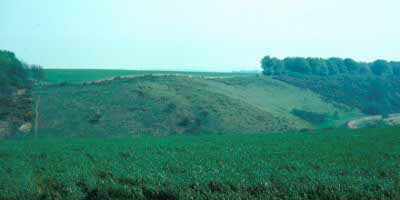Conservation
The main conservation issues affecting butterflies include:
Other relevant issues are:
- Collecting - less popular than in the past, but a threat to
colonies of scarce species with small populations
- Releases of specimens reared in captivity - which can upset
the balance between population size and foodplant availability. It
can also introduce different genetic stock, perhaps damaging the
local population's chance of survival
- Erosion from public access and recreational use - some sites
have suffered from heavy use
Other wildlife interest
The habitat for uncommon or scarce butterfly species supports a
very wide variety of other forms of wildlife. Some is still reasonably
common and widespread in the countryside, some is confined to
a particular type of habitat.
Some rarities are found in just one or a few sites in the area.
Examples include numerous plants (e.g. some orchids), and many
species of invertebrate (other types of insect, spiders, snails etc).
Good butterfly habitat supports our local biodiversity, and
conservation measures need to take other wildlife interest into account.
Habitat destruction
Much of the unimproved grassland which remains in the Cotswolds is on
steep slopes. Most of the more level areas have already been
ploughed up or treated with fertilisers and pesticides, with the
result that most of their natural history interest has been lost.
Even the steeper sites are at risk of destruction: small remaining
areas of steep unimproved grassland are sometimes planted with trees.
Species which have lost colonies for this reason include
Duke of Burgundy and
Chalk-hill Blue
Other changes in land use can also destroy butterfly habitat, but
indirect destruction through lack of management is probably a greater
threat.
Lack of management - grassland
Lack of management - woodland
Most woodland butterflies need open areas along tracks, in clearings
and in scrubby areas. In woodland which is actively managed as commercial
forestry there are plenty of such open areas. In woodland which is
allowed to mature to dense stands of tall trees with no regular felling,
open areas soon become shaded out and the wood becomes unsuitable
for some butterfly species.
The Pearl-bordered Fritillary
used to occur in many Cotswold woodlands. It has now gone from most
of them, and whether or not lack of management was the original
reason for this, many former sites are no longer suitable for the
species.
Too much grazing
Moderate levels of grazing, usually by sheep or cattle, can maintain
unimproved grassland in ideal conditions for butterflies, flowers and
other forms of wildlife.
Long periods of heavy grazing make a site much less suitable for
butterflies, by removing either the larval habitat or the nectar sources
for adults. Adult butterflies also need some tall grass or other
vegetation on which to rest overnight.
One strong Small Blue
colony was centred on part of a grassland field, and its eggs could be
found on several much smaller patches of kidney vetch in the surrounding
area, including two roadside embankments.
Most of the field was ploughed up and although the main area
of kidney vetch remained, it was then grazed much more heavily than in
the past. The main Small Blue colony seems to have died out, and it has
also not been recorded on most of the smaller sites since then.
One large area of unimproved grassland is managed mainly for its
botanical interest, and grazed heavily. It does have quite a good range
of grassland butterfly species, but populations are much lower than on
smaller lightly-grazed sites. It too has lost its former colony of
Small Blue.
Heavy grazing in woodland can have a similar effect, and parts of the
Forest of Dean are not as good for butterflies as one might expect.
Colony isolation
For some scarce species, loss of habitat has left many of their
colonies isolated on small areas of good habitat in an otherwise
unsuitable landscape. Such colonies are very vulnerable to local
extinction from a range of causes, and their isolation makes natural
recolonisation very unlikely. Several colonies of
Duke of Burgundy and
Grizzled Skipper seem to have been
lost in this way, even though the sites now appear to remain suitable.
Disease and parasites
Habitat changes or weather conditions often appear to be the cause
of population declines, but sometimes there is no obvious cause
and disease or parasitism seem more likely.
It is known that as the Holly Blue
population builds up to a peak over several years, so too does the
population of a parasite which eventually causes a crash in the
populations of both. The cycle then repeats.
Environmental changes
Global warming is thought to be the reason why the distribution of
some species is expanding in Britain. In our area the
Essex Skipper is spreading across
the Cotswolds and into the Severn Vale.
Particularly wet or cold summers can reduce breeding success, leading to
population declines and local extinctions.
Particularly dry summers can also be very damaging, with larval foodplants
withering and nectar sources drying up quickly. What was perhaps the best
Duke of Burgundy
colony in the area became just another small colony after a drought,
although the introduction of grazing to the site probably also made
its cowslip foodplants more vulnerable to drying out during the summer.


